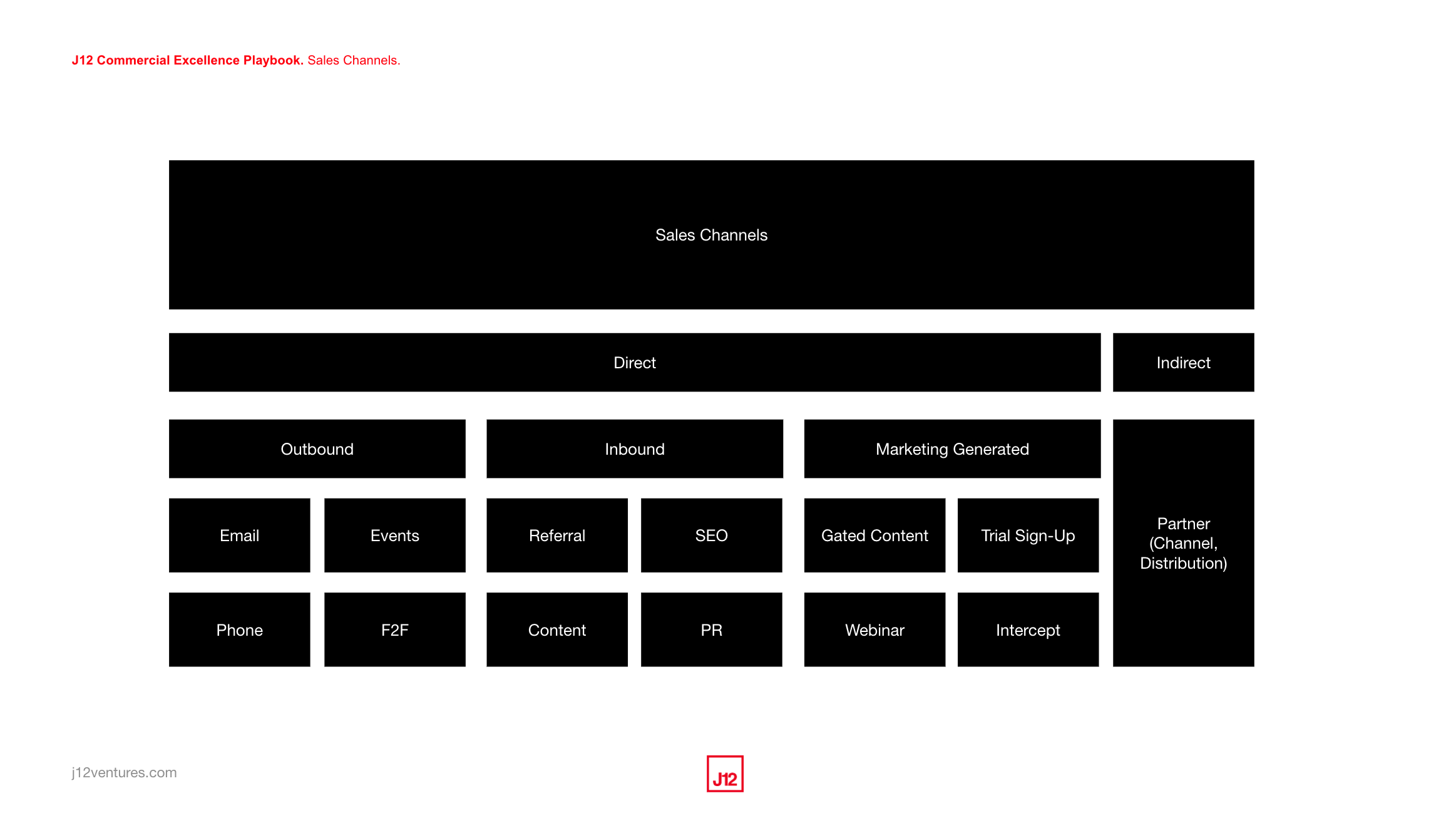J12 Commercial Excellence Playbook — The Most Important Sales Channels
Part 2/10
Selecting the right channels to market a product or service is critical for any business, and there are always a number of options on how to reach your target audience. Optimising this aspect of your Go-To-Market (GTM) strategy is the secret sauce to quicker market fit, and better commercial outcomes. Defining the right channels depends on many variables e.g. capital, team resources, assumed ICPs, business model. Not all channels will be relevant, or even plausible, to unlock consistent reliable growth. Products often fail because a company is selling through suboptimal and/or underoptimised channels. Although I hate being mechanical as the right channels varies from company to company — here is guidance on those I have seen be the most important when building a sales expertise at seed.
…
What is a Sales Channel?
A sales channel is the route through which you sell a product or service to your customer. It is a function of the product you have built and the market, and the potential buyers you wish to pursue. Early-on, you still have the advantage of being able to do certain experimentation, iteration and improvement on the set of channels you deploy, so once ready to scale, you can double-down on those that best resonate with the competitive advantage of your business and have the least friction to closing a sale.
The 4 Most Important Market Channels to Build a Sales Expertise
Outbound (Direct)
Inbound
Marketing Generated
Partnerships (Indirect)
…
Outbound (or Direct) Sales
Outbound (or Direct) Sales are those where all efforts to find, engage and onboard customers are done in-house by your sales team. At seed, alongside these dedicated sales resources, founders are often also implanted in the sales process (and so they should be). Direct Sales is by far the most effective way to learn about your product and positioning as there is neither substitute for customer feedback nor the realities of the end-user experience.
This is the natural starting point at seed stage and a great learning process. It works across all customer segments, verticals and markets (obviously with some nuances and pros and cons). For example with enterprise customers, where the sales cycles are longer, more complex and require consultation and discovery, having your team lead and manage the process is more effective than outsourcing through e.g. partnerships models.
Direct sales are applicable to small and medium sized businesses (SMBs) as well, especially in a transactional sales process with short cycles, low value average order sizes and where a prescriptive process and pitch is possible.
Further Readings: Sell More Faster by Amos Schwartzfarb.
…
Inbound Sales
Inbound Sales are enquiries that result from prior (normally direct) sales and marketing activity. This can be generated from word of mouth (organic growth), events (conferences, exhibitions, panels etc), webinars, advertising, PR coverage and so on. An efficient commercial machine will generate and convert a high volume of leads. Although there is some overlap with Marketing Generated sales (as highlighted below), ultimately inbound sales should contribute with incremental opportunities to your sales team for nurturing.
Good practice is to ensure inbound leads (and all leads in general) are always logged and classified in your CRM, as it enables you to analyse and track key sources for lead generation through each channel source as well as build valuable data and run analytics on your sales funnel metrics.
…
Marketing Generated
Marketing generated sales are through opportunities created as a result of direct efforts and marketing “call to actions” from your marketing function. Typically these opportunities are measured in terms of Marketing Qualified Leads (MQLs). Marketing generates MQLs through a variety of sources e.g. content where you are required to submit contact information, sign-ups for trial, demo, webinar attendees etc. These are all marketing generated activities triggering a potential buyer signal of engagement and interest in your proposition.
In some cases marketing tools are able to automate a sequencing of communication and actions to move prospects towards buying a product or service. In others, the involvement of a sales rep is required to close an opportunity. Either way these are marketing driven and additive to direct sales outbound effort. It can be helpful to develop a set of criteria that your MQLs should meet to qualify as leads, and ensure marketing ties these to your Ideal Customer Profile (ICP). The following 3 criteria are a good start:
Need: your product solves the prospect’s budget.
Authority: the prospect has decision-making authority.
Budget: your product is within the prospect’s budget.
And to keep things simple, if there is one single Key Performance Indicator (KPI) to obsess about from a marketing perspective, it is Lead Velocity Rate (LVR). This is how many leads the marketing function generates over time. Generally this is measured month-to-month as a temperature check on the efficiency and long-term growth prospects of your pipeline. Hence, all of your investment in marketing should be to improve your MQLs and LVR.
Further Readings: The Founder’s Guide to B2B Sales: Marketing by Balderton.
…
Partnerships
Partnerships are indirect by nature, as you leverage another brand, technology or sales organisation to take your product or service to market. They are often seen as a complex activity associated with later-stage businesses where a sales engine with mature processes and resources have already been established. But partnerships are longterm commitments and may therefore be relevant to reach your customers. Increasingly (through technology and specifically API integrations) partnerships have become an efficient way to achieve scale through automated (or lower touch) distribution of your products and services allowing higher quality pipelines and accelerated growth.
The challenge with partnerships is that they generally take a lot of time and effort to be successful — establishment, implementation, optimisation and commercialisation needs to be done before any will generate revenue — and being able to prioritise time, capital and resources is a luxury many cannot afford early-on. Partnerships can mean being further away from the customer and what is really going on in terms of user experience with your product and service. For founders and sales teams at seed, direct customer contact is invaluable as it provides critical insight, allowing you to test, learn and iterate quickly while ensuring you are close to how your product or service is used in practice. Given you need to find product-market fit and understand you ICPs and key personas, often direct selling and driving your own outbound activity is a more efficient and rewarding sales channel to start with.
Timing is ultimately key for when to explore partnerships as a sales channel. Partnerships should only be pursued once you have evidenced who your target audience is and a proven fit in the market of repeatability and scaling in existing, established (direct) channels.
In the current economic climate, partnerships are even more challenging to build. Companies are prioritising direct sales and putting their own products and services first. You are likely to be deprioritised (if prioritised at all), so my suggestion would be doubling down on existing channels that are already working rather than considering new channels. If and when you go down the partnership route, be selective and strict on criteria and stress testing, set up clear agreements on goals and desired outcomes. The best partnerships bring equal value and are additive to everyone in volume and value.
Further Readings: The Importance of Partnerships in the Great Unbundling by a16z, Partnerships 101 by Crossbeam.
…
Access the google slide templates here:
The J12 Commercial Excellence Playbook — All Template Slides (2022).


